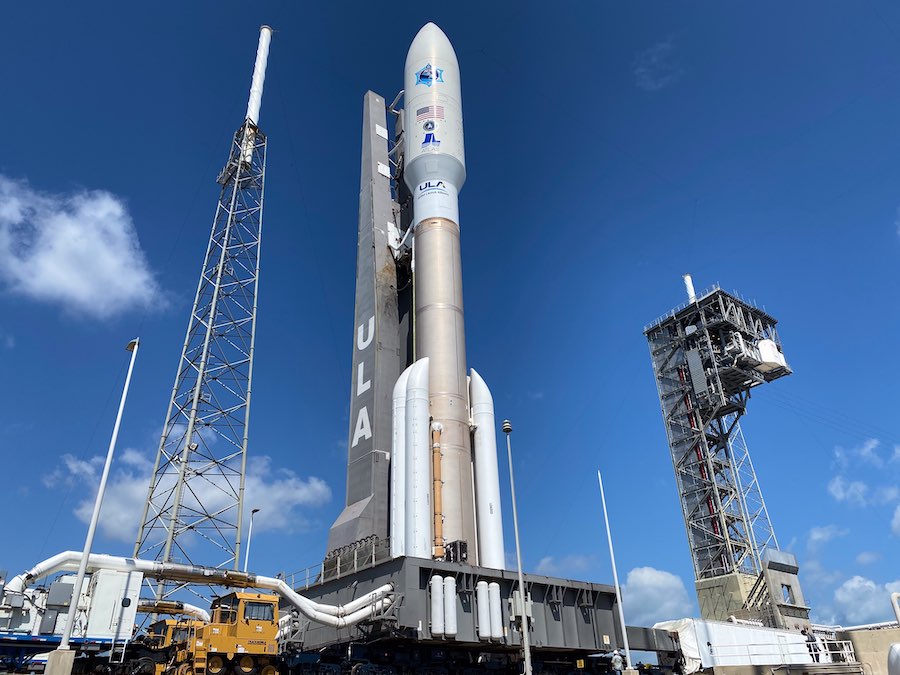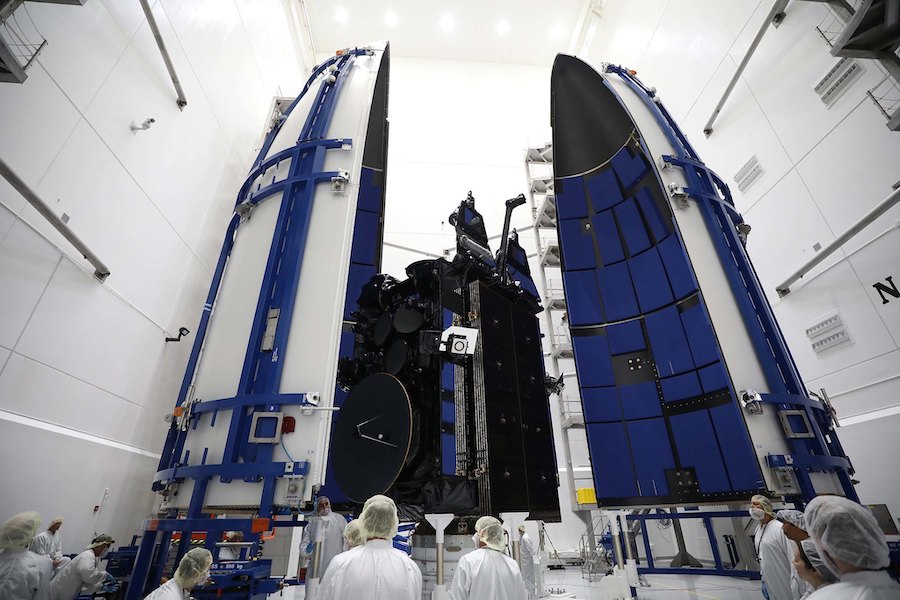Space Force’s first launch scheduled for Thursday – Spaceflight Now

The first launch of a U.S. Space Force mission since the establishment of the new military service is planned Thursday, when a United Launch Alliance Atlas 5 rocket is set for liftoff from Cape Canaveral with a billion-dollar jam-resistant communications satellite designed to ensure national leaders remain connected with the armed forces.
The sixth and final Advanced Extremely High Frequency satellite is mounted on top of the Atlas 5 rocket awaiting liftoff Thursday, heading for a post more than 22,000 miles (nearly 36,000 kilometers) above Earth.
The AEHF 6 spacecraft is the first Space Force payload to launch since the military service was established in December. The AEHF satellites — like the military’s navigation and missile warning satellite assets — were previously managed by Air Force Space Command before their transfer to the Space Force.
The Space Force remains part of the Department of the Air Force — much like the Marine Corps is part of the Department of the Navy.
“This AEHF 6 mission will be the first launch for the newly-established U.S. Space Force,” said Col. Robert Bongiovi, AEHF 6 mission director and head of the launch enterprise office at the Space Force’s Space and Missile Systems Center. “My entire team is squarely focused on ensuring mission for this satellite to provide certain, secure communications for the nation and its leaders.”
Built by Lockheed Martin with a sophisticated communications payload from Northrop Grumman, the AEHF 6 spacecraft is the last in the Space Force’s AEHF fleet. Five previous AEHF satellites have launched successfully on Atlas 5 rockets since August 2010.
Each of the AEHF satellites weigh around 13,600 pounds (6,168 kilograms) fully fueled at launch.
“While this is the final AEHF satellite launch, it really brings the constellation to full strength, capability and truly marks the beginning of the AEHF system’s full lifecycle,” said Mike Cacheiro, vice president for protected communications at Lockheed Martin, in a statement. “Still, it is a bittersweet moment for everyone involved, knowing this is our last launch for the AEHF program.”
Atlas 5 launch preparations at Cape Canaveral are proceeding amid the COVID-19 coronavirus pandemic, which has disrupted launch schedules around the world. ULA and military officials said teams are engaging in social distancing to try and limit the exposure of personnel to the virus, and 20 to 25 percent of the employees who would typically be present for the launch will not be there in person Thursday.
ULA teams rolled the 197-foot-tall (60-meter) Atlas 5 rocket from its Vertical Integration Facility to Cape Canaveral’s Complex 41 launch pad Wednesday in preparation for Thursday’s launch, which is scheduled at the opening of a two-hour window at 2:57 p.m. EDT (1857 GMT).
There is an 80 percent chance of favorable weather for launch Thursday, with mostly sunny skies and warm temperatures in the forecast.
Mounted on a mobile launch platform, the Atlas 5 followed rail tracks laid along the third-of-a-mile distance between the vertical hangar and pad 41. After arriving at the launch pad, the Atlas 5’s first stage was fueled with rocket-grade kerosene ahead of the start of the seven-hour countdown Thursday.
During Thursday’s countdown, ULA’s launch team will activate the rocket’s avionics and guidance system, run the Atlas 5 through a series of launch day checkouts, and fill the launcher with super-cold liquid hydrogen and liquid oxygen propellants.

During a final built-in told at T-minus 4 minutes, ULA’s launch conductor will poll the Atlas 5 team for approval to begin the terminal countdown. Once the countdown clocks resumes, the Atlas 5 will be switched to internal battery power and its propellant tanks will pressurize in the final four minutes before launch.
In the last moments of the countdown, the first stage’s Russian-made RD-180 main engine will start up, followed by ignition of the Atlas 5’s five strap-on solid rocket boosters, which were manufactured by Aerojet Rocketdyne.
The main engine and solid rocket boosters will combine to generate around 2.6 million pounds of thrust, sending the Atlas 5 eastward over the Atlantic Ocean.
The Atlas 5 rocket will fly in its most powerful configuration, known as the 551 variant, for Thursday’s mission. The launcher has a 5.4-meter-diameter (17.7-foot) payload fairing built in Switzerland by RUAG Space.
The rocket will shed its strap-on boosters at T+plus 1 minute, 46 seconds, leaving the liquid-fueled RD-180 engine to power the Atlas 5 until about four-and-a-half minutes into the mission. During that time, the Atlas 5’s payload shroud will jettison to fall into the Atlantic Ocean.
Then the rocket’s Centaur upper stage will ignite its Aerojet Rocketdyne RL10C engine for the first of three planned burns to inject the AEHF 6 spacecraft into its planned elliptical geostationary transfer orbit. The RL10C engine will shut down at T+plus 11 minutes, 46 seconds, then reignite about 11 minutes later for a second firing.
After the first Centaur burn, the rocket will release a small secondary payload named TDO 2 into orbit around 31 minutes after liftoff.
Based on a suitcase-sized 12U CubeSat platform, TDO 2 carries multiple U.S. government payloads that will provide optical calibration capabilities, which will support space domain awareness, according to the U.S. Space Force’s Space and Missile Systems Center.
“The mission of TDO 2 is to support space domain awareness through optical calibration and satellite laser ranging,” SMC said in a statement. “This capability will assist the nation’s warfighters in performing their critical missions.”
The TDO 2 spacecraft was manufactured by Georgia Institute of Technology and sponsored by Air Force Research Laboratory, according to SMC. It is mounted to the aft end of the Atlas 5’s Centaur upper stage.
A similar secondary payload named TDO 1 accompanied the AEHF 5 satellite into orbit on a previous Atlas 5 launch in August 2019.

Once the TDO 2 payload is deployed, the Centaur upper stage will coast for more than five hours. As the rocket reaches the high point of its orbit more than 20,000 miles from Earth, the RL10C engine will fire once more to raise the orbit’s perigee, or low point, and nudge its tilt closer to the equator.
With that maneuver completed, the Centaur will release the AEHF 6 spacecraft around 5 hours, 41 minutes, after liftoff. The target orbit for Thursday’s mission ranges in altitude between 6,758 miles (10,876 kilometers) and 21,933 miles (35,298 kilometers), with an inclination of 13.9 degrees.
The AEHF 6 satellite will use its own engine and plasma thrusters to maneuver into a circular geostationary orbit more than 22,000 miles over the equator, where the craft’s speed will match the rate of Earth’s rotation. That will allow AEHF 6 to remain over the same part of the world 24 hours per day.
Military officials have not disclosed the geographic coverage area for AEHF 6.
Designed to operate at least 14 years, the AEHF satellites are follow-ons to the Air Force’s Milstar satellite network.
Each of the AEHF satellites, which are spread around the world to enable global coverage, provides more capacity than the entire five-satellite Milstar constellation, which launched in the 1990s and 2000s. The AEHF satellites are cross-linked with one another, allowing the network to beam signals around the world without going through a ground station.
AEHF 6 will go straight into operations once it passes post-launch tests, according to Col. John Dukes, Jr., senior materiel leader for the geosynchronous orbit division SMC’s production corps.
The AEHF satellites provide connectivity at different specified data rates between 75 bits per second to 8 megabits per second. Those data rates are slow by modern standards, but what distinguishes the AEHF satellites is their ability to resist jamming and continue operating, even in the event of nuclear war.
Each satellite also carries gimbaled dish antennas to reach users on-the-move, phased array antennas with beams can be steered electronically rather than mechanically, and nulling antennas to provide “extremely high anti-jam capability to in-theater users,” according to Northrop Grumman, supplier of the AEHF communications payload.
“AEHF, if we were to have to operate in (the highest bandwidth) mode, will enable the President of the United States, national leaders and four international allies to be able to communicate in voice-recognizable communication, even through any event,” Dukes said.
The governments of Australia, Canada, the Netherlands and the United Kingdom have joined the AEHF program.
“Across the globe, we have numerous Army, Navy, Air Force, and joint international partner terminals with the AEHF constellation online,” Dukes said. “We have enough bandwidth to service all the terminals in our concept of operations. So by upgrading from the Milstar to the AEHF constellation, we’re able to provide that capability from now to beyond 2030.”
Email the author.
Follow Stephen Clark on Twitter: @StephenClark1.





